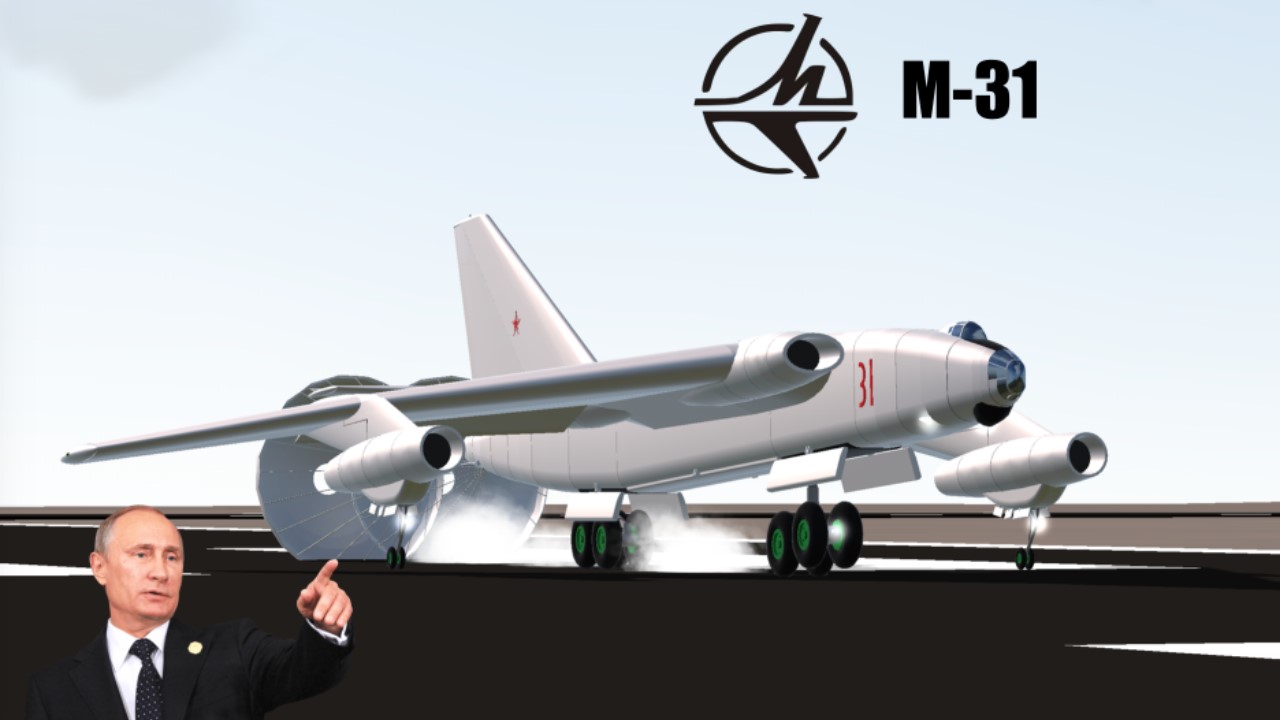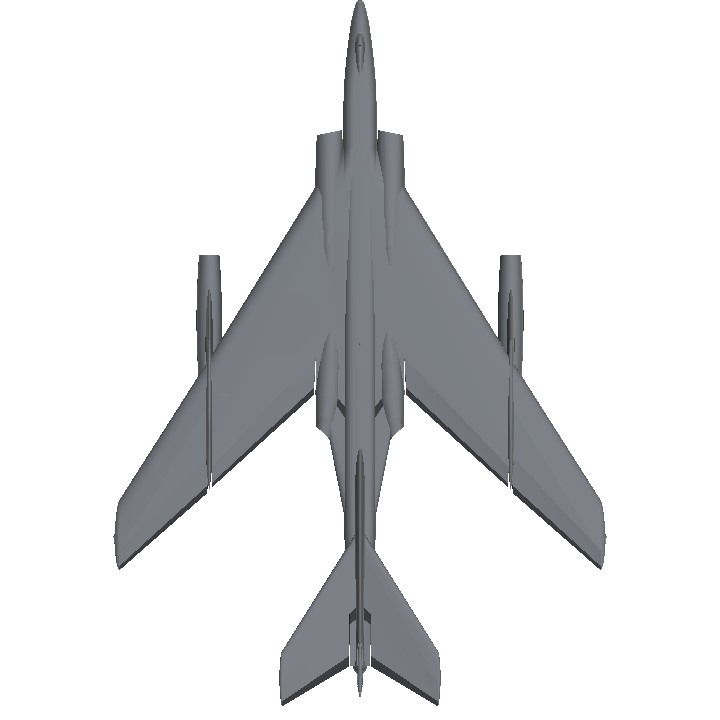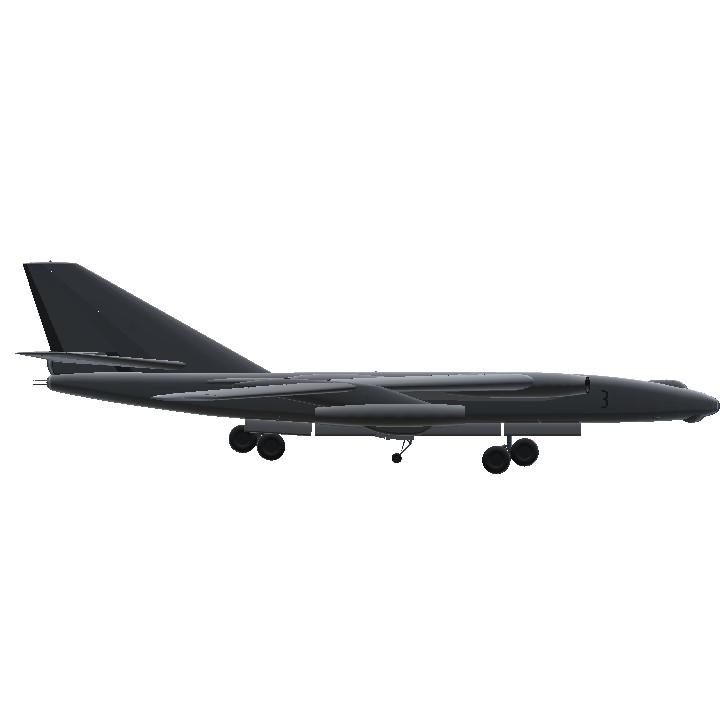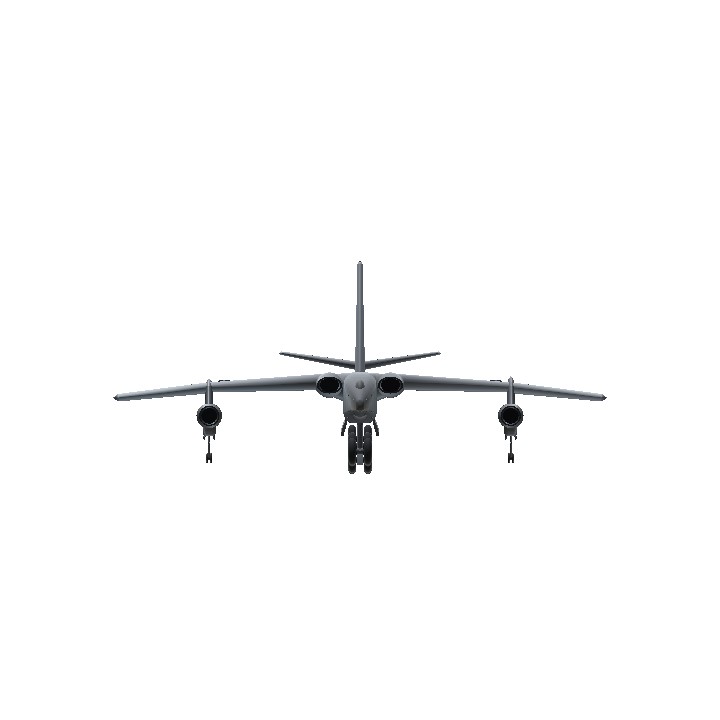A humungous early 1950s heavy bomber designed to fly at transonic airspeeds in order to reduce the chance of interception from supersonic fighters. Technology overcame this beastly project before it could be built.


Controls
- AG-1 - Open bomb bay doors
- AG-2 - Stabilize aircraft and activate defensive turret. Control it with pitch & roll
- AG-3 - Brake chutes
- AG-7 - Navigational lights
- VTOL - Flaps
- Throttle greater than 95% - Afterburner
Features
- Fully functioning defensive turret with four 23mm NR-23 cannon
- Six custom 1,500 kg FAB-1500 M-54 bombs
- Four Dobrynin VD-5F afterburning turbojets
- Afterburning smoke effect
- Dynamic bicycle landing gear
- Custom wings and control surfaces
History
The development of supersonic fighters meant that any new strategic bomber would itself need transonic or even supersonic performance to try and avoid being intercepted. However, the aerodynamics and structures needed in a bomber airframe to make it capable of such speeds would require a considerable amount of new research and experimentation and the Myasishchev OKB got moving on this in 1952. It was confirmed that increasing speed from Mach 0.7 to about Mach 1.1 brought a big drop in range because of both the rise in fuel consumption and the reduction in lift delivered by a sweptback wing. Increases in wing sweep reduced the takeoff performance while a thinner wing pushed up the structural weight. Nevertheless, in co-operation with TsAGI, the design bureau began work on a heavy transonic bomber called ‘Article 31’ or M-31.
Myasishchev M-31 (1952)

A 55° sweep wing was selected after wind tunnel results for alternative high sweepback or rhomboid shaped wings had been analyzed. The M-31 was to have four Dobrynin VD-5 engines and the possible alternative arrangements would have all four of these in the fuselage or to put two under the wings on pylons with the other pair in the wing roots. However, the M-31’s wing thickness/chord ratio was 6% maximum, which meant that the wing skins would be relatively thick, so the second format offered a saving in weight while keeping down the size of the fuselage; in addition using pylon-mounted engines would improve the wing’s flutter characteristics by pushing up the critical speed at which this phenomenon appeared. Such a thin wing also prevented the use of a tricycle undercarriage, a zero-track bicycle type being fitted instead, while RATO equipment supplying up to 44,000 lbs (195.6 kN) of additional thrust would be used on takeoff.
Custom M-31 model by John Hall

The M-31 could carry one 19,841 lb (9,000 kg) FAB-9000, two 13,228 lb (6,000 kg) BRAB-6000, three 6,614 lb (3,000 kg) FAB-3000, six 3,307 lb (1,500 kg) FAB-1500, twenty 1,102 lb (500 kg) FAB-500, or thirty-six 551 lb (250 kg) FAB-250 bombs, or two 3,527 lb (1,600 kg) guided bombs or six torpedos or sea mines. For rear defense a battery of two or four 23mm cannon was provided at the end of the fuselage and four crew were carried. The airframe structure was all-metal, mainly V-95 light alloy, with a semi-monocoque oval-shaped fuselage and a central bomb bay. The wing used box-spar construction and the fuel (216,049 lbs [98,000 kg] in total) was housed in both wings and fuselage. A “Rubin-1” bombing radar was carried and the aircraft was expected to offer a range of 4,972 miles (8,000 km) and a service ceiling of 49,213 ft (15,000 m).
John Hall’s model of the M-31. It gives an indication of the design’s considerable bulk.

A preliminary project was presented to the MAP for review in August 1952, but Myasishchev’s designers recognized that much more research would probably be needed before they could begin to design and build a bomber of this size for hitting major military and industrial targets, particularly one that offered even better performance.
M-31 Estimated Data
Span - 113.8 ft (34.64 m)
Length - 160.9 ft (49 m)
Gross Wing Area - 4,301 ft2 (400 m2)
Maximum Weight - 401,235 lbs (182,000 kg)
Powerplant - 4x Dobrynin VD-5 turbojets
Thrust - 28,660 lbs (127.4 kN)
Maximum Speed - 684 mph (1,100 km/h) at 36,089 ft (11,000 m)
Armament - 2x or 4x 23mm cannon, up to 26,455 lbs (12,000 kg) of bombs.
Source: Tony Buttler & Yefim Gordon, Soviet Secret Projects Bombers Since 1945 (Midland Publishing, 2004), pp. #54, 55, 69, 165.
Acknowledgements
- asteroidbook345 - Helping with landing gear design
- BogdanX - Helping tremendously with landing gear balancing
- edensk - Assisting with Funky Trees inputs.
Specifications
Spotlights
- Feanor 5.6 years ago
- Dimkal 5.6 years ago
- ChiChiWerx 5.6 years ago
- MAHADI 5.6 years ago
- CRJ900Pilot 5.6 years ago
- rumiyote 5.6 years ago
- RussianAce 5.6 years ago
- BlackhattAircraft 5.6 years ago
- F4f879 5.6 years ago
- JohnnyBoythePilot 5.6 years ago
- Bife 5.6 years ago
- Guiso 5.6 years ago
- Renameduser4 5.6 years ago
- ACEPILOT109 5.6 years ago
- Typhoon03 5.6 years ago
General Characteristics
- Predecessor [CLOSED] USSR Cold War Bomber Challenge
- Successors 2 airplane(s) +7 bonus
- Created On Mac
- Wingspan 85.3ft (26.0m)
- Length 115.9ft (35.3m)
- Height 36.7ft (11.2m)
- Empty Weight 81,598lbs (37,012kg)
- Loaded Weight 261,538lbs (118,631kg)
Performance
- Power/Weight Ratio 0.567
- Wing Loading 102.6lbs/ft2 (500.8kg/m2)
- Wing Area 2,549.7ft2 (236.9m2)
- Drag Points 30212
Parts
- Number of Parts 685
- Control Surfaces 7
- Performance Cost 3,360





No. It wasn’t even produced. This airplane did not progress past the scale modeling stage. And no passenger version was even considered as the only purpose in mind was a heavy bomber. @Yosann
Did This Aeroplane used For Aeroflot to transport Passengers @AircraftoftheRedStar?
Thank you man!
@Yosann
@AircraftoftheRedStar your aircraft is amazing!
@AircraftoftheRedStar huh
thanks for the info!
Thanks man! It is an XML attribute through overload. Just make a new line and put “name” (without the quotes lol) then whatever you want it to be.
@Ryn176
Cool, good job getting featured on Frantic Matty's video!
May I ask, how did you give the bomb custom names?
Thanks Comrade!
@AinoerAerospaceInc
This really looks like Soviet hahaha amazing work!
Thank you for the spotlight!
@Dimkal
Lol.
@M7MDRHX
"simpleplanes"
Huh... More like
OURPLANES
Thanks for the spotlight!
@JohnnyBoythePilot
@AircraftoftheRedStar Np!
Thank you for the spotlight!
Thanks for the spotlight!
@USSR
I will! Glad you like it!
@Antontheilluminati
Absolutely loving it! Never thought about making the early Myasischevs, yet now I want to build one. Keep up the good work!
@AircraftoftheRedStar np!
Thanks for the spotlights!
@RussianAS
@MAHADI
Thank you. I'm glad you like it!
@MrPorg137
@MAHADI
@ReignSUPREME
That's the thing with unbuilt projects. It has a wing shape that was never really tested in reality, so that makes performance really tough to recreate. The flap's effectiveness was really hard on this one. I could have had the nose not balloon up so bad, but it would make a really high landing speed. This was about as slow as I could make the landing speed without having the plane go out of control. Thanks for your opinion and spotlight!
@ChiChiWerx
nice
sleek and cool
I will give you your upvotes soon